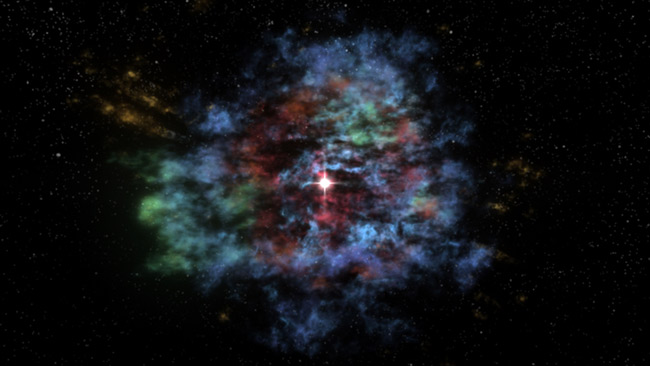Dead Exploded Star Resurrected in 3-D

The dying remains of anexploded star have been resurrected in a new three-dimensional film that fliesthrough the ancient supernova.
At center stage inthe new movie is Cassiopeia A, a dead star that exploded about 330 yearsago to forge one of the youngest supernova graves in the Milky Way galaxy.
Astronomers usedobservations from several ground- and space-based telescopes to build the 3-D voyagethrough the supernova, which starts at the remnant?s neutron star core. The moviethen pulls back to reveal the wispy, gaseous remains ofCassiopeia A in hues of red, green, yellow and blue to mark materials seenin different wavelengths.
"We have always wantedto know how the pieces we see in two dimensions fit together with each other inreal life," said Tracey Delaney of the Massachusetts Institute ofTechnology, whose team reconstructed the event. "Now we can see forourselves with this 'hologram' of supernova debris."
The movie and a separatestudy on the same supernova remnant were announced this week at the 213thmeeting of the American Astronomical Society in Long Beach, Calif.
In the separate study,astronomers collected a series of time-lapse images of Cassiopeia A?s recent evolution usingeight years of observations from the ChandraX-Ray Observatory. That study found that 30 percent of the supernova?senergy ended up as high-speed cosmic rays.
And by virtually flyingthrough thesupernova remnant, scientists discovered two separate components: aspherical outer shell and a flat, disk-like inner layer. Jets of silicon andiron were spotted in the inner disk, but scientists were surprised to see theirbroad, disk-like structure, researchers said. The finding suggests that theinnermost layers of an exploding star erupt as high-speed plumes, while theoutermost regions expand like a spherical bubble.
Breaking space news, the latest updates on rocket launches, skywatching events and more!
"With Chandra, we havewatched Cas A over a relatively small amount of its life, but so far the showhas been amazing," said astronomer Daniel Patnaude of the SmithsonianAstrophysical Observatory in Cambridge, Mass. "And, we can use this tolearn more about the aftermath of the star's explosion."
- NewVideo - Flying Through a Supernova?s Grave
- Video- Supernovas: Beacons in the Night
- Images- The Chandra X-Ray Observatory?s First Years
Join our Space Forums to keep talking space on the latest missions, night sky and more! And if you have a news tip, correction or comment, let us know at: community@space.com.

Tariq is the award-winning Editor-in-Chief of Space.com and joined the team in 2001. He covers human spaceflight, as well as skywatching and entertainment. He became Space.com's Editor-in-Chief in 2019. Before joining Space.com, Tariq was a staff reporter for The Los Angeles Times covering education and city beats in La Habra, Fullerton and Huntington Beach. He's a recipient of the 2022 Harry Kolcum Award for excellence in space reporting and the 2025 Space Pioneer Award from the National Space Society. He is an Eagle Scout and Space Camp alum with journalism degrees from the USC and NYU. You can find Tariq at Space.com and as the co-host to the This Week In Space podcast on the TWiT network. To see his latest project, you can follow Tariq on Twitter @tariqjmalik.
